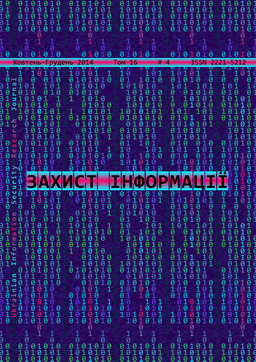On the computational security of randomized stream ciphers proposed by Mihaljević and Imai
DOI:
https://doi.org/10.18372/2410-7840.16.7619Keywords:
symmetric cryptography, randomized encryption, stream cipher, random coding, wiretap channel, LPN problem, correlation attackAbstract
This paper yields a (computational) security analysis for a generic class of randomized stream ciphers based on joint employmentof encryption, error-correction coding, and dedicated random coding. We show that the security of these ciphers can be considerablyless than their designers claim. In contrast to the approach for security evaluation used before, our technique is significantly simplerand allows us to find out the code-theoretic sense of parameters that determine the security of these ciphers. We also proposeanother possible solution (based on nonlinear random coding) for design of randomized stream ciphers with enhanced security.References
. Alekseychuk A. N., Gryshakov S. V., (2004) “Nonlinear random coding for information transmission systems with the wire-tap”, Legal, regulatory and metrological support information security system in Ukraine., Vol. 8, PP. 133-140.
. Alekseychuk A. N., (2007) “Analytical bounds of parameters that determine the provable security of randomized block ciphers against differential cryptanalysis”, Zakhist Inform, No 2., PP. 12-23.
. Alekseychuk A. N., (2007) “Sufficient conditions for randomized block cipher-systems to be secure against commutative diagram cryptanalysis”, Data Recording, Storage and Processing. ,Vol. 9., No 2., PP. 61-68.
. Logachev O.A., Sal’nikov A.A., Yashchenko V.V., (2004) “Boolean functions in coding theory and cryptology”, MCCME, Moscow.
. Canteaut A. (2005), “Fast correlation attacks against stream ciphers and related open problems”, The 2005 IEEE Information Theory Workshop on Theory and Practice in Information-Theoretic Security – ITW 2005, EProc. (6 p.), Awaji Island, Japan.
. Gilbert H., Robshaw M.J.B., Seurin Y. (2008), “How to encrypt with the LPN problem”, ICALP 2008, Part II, Lecture Notes in Computer Science, Vol. 5126, PP. 679-690.
. MacWilliams F.J., Sloane N.J.A. (1977), “The theory of error-correcting codes”, North Holland, Amsterdam.
. Mihaljević M.J., Imai H. (2008), “A stream ciphering approach based on wiretap channel coding”, 8th Central European Conference of Cryptography, Graz, Austria, July 2-4, E-Proc. (3 p.).
. Mihaljević M.J., Imai H. (2009), “An approach for stream cipher design based on joint computing over random and secret data”, Computing, Vol. 85, No 1-2, June 2009, PP. 153-168.
. Mihaljević M.J., Oggier F., Imai H. (2010), “Homophonic coding design for communication systems employing the encoding-encryption paradigm”, in arXiv:1012.5895v1 [cs.CR], 29 Dec.
. Mihaljević M.J., Imai H. (2011), “Employment of homophonic coding for improvement of certain encryption approaches based on the LPN problem”, Symmetric Key Encryption Workshop – SKEW 2011, Copenhagen, Denmark, Feb. 16-17, E-Proc. (17 p.).
. Mihaljević M.J., Imai H. (2011), “An informationtheoretic and computational complexity security analysis of a randomized stream cipher model”, 4th Western European Workshop on Research in Cryptology – WeWoRC 2011, Weimar, Germany, July 20-22, Conf. Record PP. 21-25.
. Oggier F., Mihaljević M.J. (2010), “An informationtheoretic analysis of the security of communication systems employing the encoding-encryption paradigm”, in arXiv:1008.0968v1 [cs.CR], 5 Aug.
. Thangaraj A., Dihidar S., Calderbank A.R., McLaughlin S.W., Merolla J.-M. (2007), “Applications of LDPC codes to the wiretap channel”, IEEE Trans. Information Theory, Vol. 53, No 8, PP. 2933-2945.
. Wyner A.D. (1975), “The wire-tap channel”, Bell. Systems Technical Journal, Vol. 54, PP. 1355-1387.
Downloads
Published
Issue
Section
License
Authors who publish with this journal agree to the following terms:- Authors retain copyright and grant the journal right of first publication with the work simultaneously licensed under a Creative Commons Attribution License that allows others to share the work with an acknowledgement of the work's authorship and initial publication in this journal.
- Authors are able to enter into separate, additional contractual arrangements for the non-exclusive distribution of the journal's published version of the work (e.g., post it to an institutional repository or publish it in a book), with an acknowledgement of its initial publication in this journal.
- Authors are permitted and encouraged to post their work online (e.g., in institutional repositories or on their website) prior to and during the submission process, as it can lead to productive exchanges, as well as earlier and greater citation of published work (See The Effect of Open Access).

